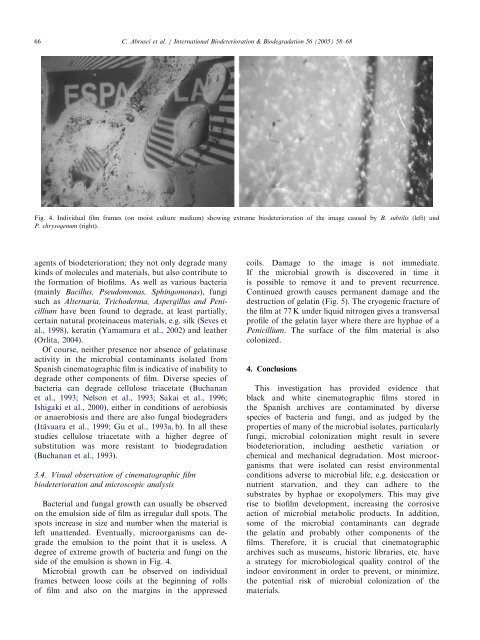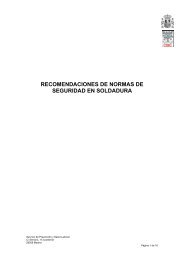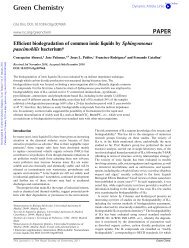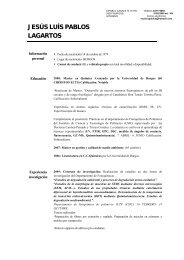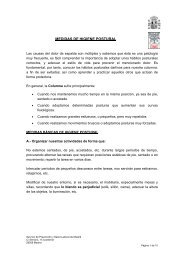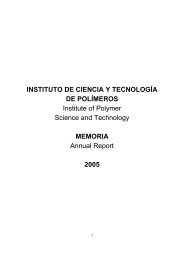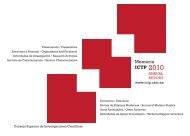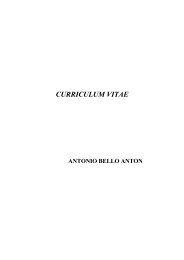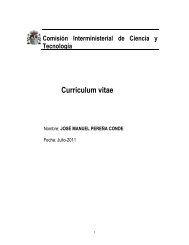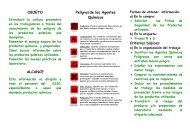Isolation and identification of bacteria and fungi from ... - ictp
Isolation and identification of bacteria and fungi from ... - ictp
Isolation and identification of bacteria and fungi from ... - ictp
- No tags were found...
Create successful ePaper yourself
Turn your PDF publications into a flip-book with our unique Google optimized e-Paper software.
66<br />
ARTICLE IN PRESS<br />
C. Abrusci et al. / International Biodeterioration & Biodegradation 56 (2005) 58–68<br />
Fig.4.Individual film frames (on moist culture medium) showing extreme biodeterioration <strong>of</strong> the image caused by B. subtilis (left) <strong>and</strong><br />
P. chrysogenum (right).<br />
agents <strong>of</strong> biodeterioration; they not only degrade many<br />
kinds <strong>of</strong> molecules <strong>and</strong> materials, but also contribute to<br />
the formation <strong>of</strong> bi<strong>of</strong>ilms.As well as various <strong>bacteria</strong><br />
(mainly Bacillus, Pseudomonas, Sphingomonas), <strong>fungi</strong><br />
such as Alternaria, Trichoderma, Aspergillus <strong>and</strong> Penicillium<br />
have been found to degrade, at least partially,<br />
certain natural proteinaceus materials, e.g. silk (Seves et<br />
al., 1998), keratin (Yamamura et al., 2002) <strong>and</strong> leather<br />
(Orlita, 2004).<br />
Of course, neither presence nor absence <strong>of</strong> gelatinase<br />
activity in the microbial contaminants isolated <strong>from</strong><br />
Spanish cinematographic film is indicative <strong>of</strong> inability to<br />
degrade other components <strong>of</strong> film.Diverse species <strong>of</strong><br />
<strong>bacteria</strong> can degrade cellulose triacetate (Buchanan<br />
et al., 1993; Nelson et al., 1993; Sakai et al., 1996;<br />
Ishigaki et al., 2000), either in conditions <strong>of</strong> aerobiosis<br />
or anaerobiosis <strong>and</strong> there are also fungal biodegraders<br />
(Itävaara et al., 1999; Gu et al., 1993a, b).In all these<br />
studies cellulose triacetate with a higher degree <strong>of</strong><br />
substitution was more resistant to biodegradation<br />
(Buchanan et al., 1993).<br />
3.4. Visual observation <strong>of</strong> cinematographic film<br />
biodeterioration <strong>and</strong> microscopic analysis<br />
Bacterial <strong>and</strong> fungal growth can usually be observed<br />
on the emulsion side <strong>of</strong> film as irregular dull spots.The<br />
spots increase in size <strong>and</strong> number when the material is<br />
left unattended.Eventually, microorganisms can degrade<br />
the emulsion to the point that it is useless.A<br />
degree <strong>of</strong> extreme growth <strong>of</strong> <strong>bacteria</strong> <strong>and</strong> <strong>fungi</strong> on the<br />
side <strong>of</strong> the emulsion is shown in Fig.4.<br />
Microbial growth can be observed on individual<br />
frames between loose coils at the beginning <strong>of</strong> rolls<br />
<strong>of</strong> film <strong>and</strong> also on the margins in the appressed<br />
coils.Damage to the image is not immediate.<br />
If the microbial growth is discovered in time it<br />
is possible to remove it <strong>and</strong> to prevent recurrence.<br />
Continued growth causes permanent damage <strong>and</strong> the<br />
destruction <strong>of</strong> gelatin (Fig.5).The cryogenic fracture <strong>of</strong><br />
the film at 77 K under liquid nitrogen gives a transversal<br />
pr<strong>of</strong>ile <strong>of</strong> the gelatin layer where there are hyphae <strong>of</strong> a<br />
Penicillium.The surface <strong>of</strong> the film material is also<br />
colonized.<br />
4. Conclusions<br />
This investigation has provided evidence that<br />
black <strong>and</strong> white cinematographic films stored in<br />
the Spanish archives are contaminated by diverse<br />
species <strong>of</strong> <strong>bacteria</strong> <strong>and</strong> <strong>fungi</strong>, <strong>and</strong> as judged by the<br />
properties <strong>of</strong> many <strong>of</strong> the microbial isolates, particularly<br />
<strong>fungi</strong>, microbial colonization might result in severe<br />
biodeterioration, including aesthetic variation or<br />
chemical <strong>and</strong> mechanical degradation.Most microorganisms<br />
that were isolated can resist environmental<br />
conditions adverse to microbial life, e.g. desiccation or<br />
nutrient starvation, <strong>and</strong> they can adhere to the<br />
substrates by hyphae or exopolymers.This may give<br />
rise to bi<strong>of</strong>ilm development, increasing the corrosive<br />
action <strong>of</strong> microbial metabolic products.In addition,<br />
some <strong>of</strong> the microbial contaminants can degrade<br />
the gelatin <strong>and</strong> probably other components <strong>of</strong> the<br />
films.Therefore, it is crucial that cinematographic<br />
archives such as museums, historic libraries, etc.have<br />
a strategy for microbiological quality control <strong>of</strong> the<br />
indoor environment in order to prevent, or minimize,<br />
the potential risk <strong>of</strong> microbial colonization <strong>of</strong> the<br />
materials.


